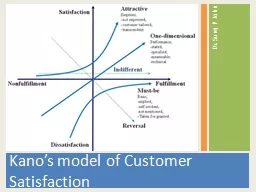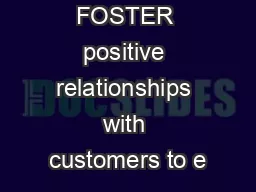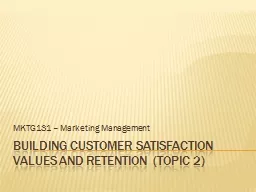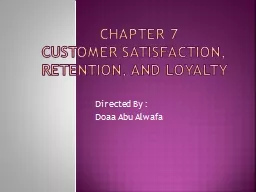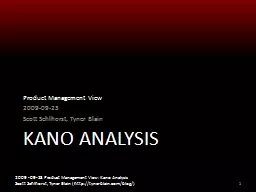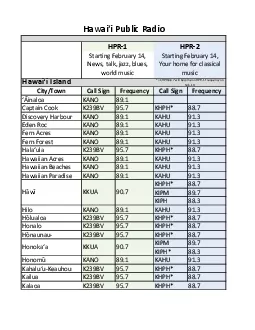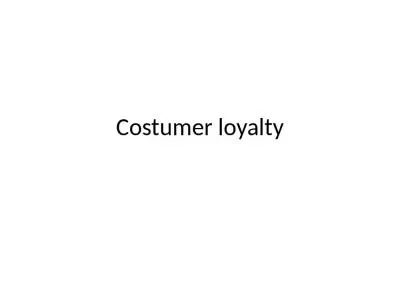PPT-Kano’s model of Customer Satisfaction
Author : dailyno | Published Date : 2020-08-04
Dr Surej P John Origin of the Kano Model Noriaki Kano Professor at Tokyo Rika University International Consultant Received individual Demming Prize in 1997 Introduction
Presentation Embed Code
Download Presentation
Download Presentation The PPT/PDF document "Kano’s model of Customer Satisfaction" is the property of its rightful owner. Permission is granted to download and print the materials on this website for personal, non-commercial use only, and to display it on your personal computer provided you do not modify the materials and that you retain all copyright notices contained in the materials. By downloading content from our website, you accept the terms of this agreement.
Kano’s model of Customer Satisfaction: Transcript
Dr Surej P John Origin of the Kano Model Noriaki Kano Professor at Tokyo Rika University International Consultant Received individual Demming Prize in 1997 Introduction Productservice quality is main antecedent of customer satisfaction . com January 2014 UKCSI January 2014 The state of customer satisfaction in the UK Institute of Customer Service foreword Overall customer satisfaction has now fallen in two consecutive UKCSI surveys This serves as a wakeup call to organisations and a Marketing 6621. What is Customer Service?. Customer service is the provision of service to customers before, during and after a purchase.. Identify beliefs held by employees who have a customer-service mindset. How to Delight Your Customers. A. . Nitipan. . Ratanasawadwat. Assumption University of Thailand. Origins of the Kano Model. Noriaki. . Kano . Professor at Tokyo Rika University. International Consultant. MKTG131 – Marketing Management. WHY STUDY CUSTOMER . SATISFACTION VALUES AND . RETENTION?. To understand . how companies deliver customer value and satisfaction.. To identify . the factors that make a high performance business.. Noriaki. . Kano . Professor at Tokyo Rika University. International Consultant. Received individual . Demming. Prize in 1997. Introduction. Product/service quality is main antecedent of customer satisfaction . Directed By :. Doaa. Abu . Alwafa. . Understanding Customer-Defined Quality. In a total quality setting, quality is defined by the customer.. The following points about customer-defined quality:. The customer must be the organization’s top priority.. 2009-09-23. Scott Sehlhorst, Tyner Blain. 1. About the Author. 2. Founded Tyner Blain 2005. a. gile. Product Manager / Product Owner. 12 Years in Software. Product / Program Management / Ownership. Business Architecture / Analysis. September 18, 2014. . Process Overview. The Integrated Service Request System (ISRS) Discrepancy Break/Fix Service Requests (SRs) are evaluated for customer satisfaction. A query is run in ISRS identifying all Discrepancy Break/Fix SRs in a “Pending Closure” status. The results are converted into a report which is exported into an Excel spreadsheet and loaded into a standard letter/email. . Q1-3. Contents. Methodology. Customer Satisfaction survey. - . Summary of key results. - What drives overall satisfaction. Repairs survey. - . Summary of key results. Conclusions. Methodology. Research programme consists of two telephone surveys: Customer Satisfaction, and Responsive Repairs. . Customer Satisfaction with Luxury Hotel in Bangkok: The Influence of Housekeeping Services Quality Department of Real Estate Business, ThammaSat University, Thailand Pitinan Kawachart , Jittaporn Access 2017 Customer Satisfaction Survey December 11, 2017 The Fairfax Research Group Methodology Telephone survey Customers who rode with Access at least once in the previous six months Conducted in October 2017 City/TownCall SignFrequencyCall SignFrequencyinaloaKANO891Captain CookK239BV957KHPH887Discovery HarbourKANO891KAHUEden RocKANO891KAHU913Fern AcresKANO891KAHU913Fern ForestKANO891KAHU913HalaulaK239BV95 The loyalty business model is a business model used in strategic management in which company resources are employed so as to increase the loyalty of customers and other stakeholders in the expectation that corporate objectives will be met or... A One Day Training organized by Kano State Due Process Bureau for Small and Medium Enterprises (SME) at Tahir Guest Palace, . Nassawa. G.R.A., Kano.. 30. th. SEPTEMBER, 2020. Presented. By. Engr. .
Download Document
Here is the link to download the presentation.
"Kano’s model of Customer Satisfaction"The content belongs to its owner. You may download and print it for personal use, without modification, and keep all copyright notices. By downloading, you agree to these terms.
Related Documents

